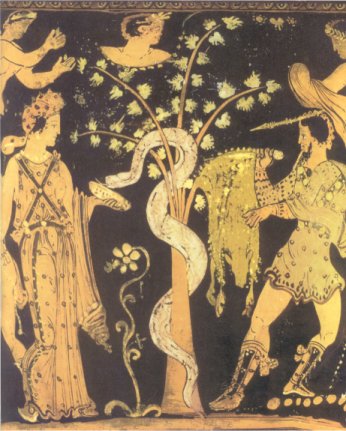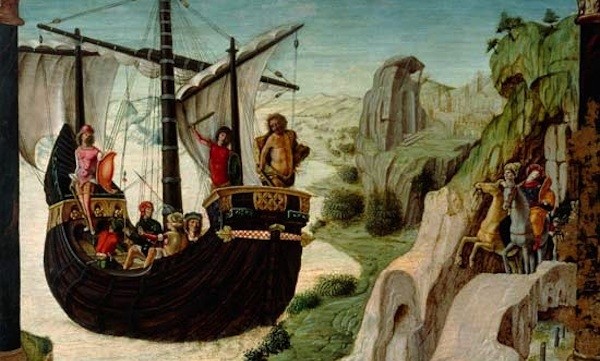 |
| Jason Retrieves the Golden Fleece |
Saint Paul in preaching to the
Greeks at Athens referred to a phrase found in Greek poetry - in the work of
that of Aratus (B.C. 272) and Cleanthes (B.C. 300) - in order to ‘win over’ his
audience by becoming as ‘a gentile to the gentiles’ so that by becoming “all
things to all men” he “might by all means save some.” (1 Cor 9:22). In Acts of
the Apostles we read: “'In him we live and move and have our being'; as even
some of your poets have said, 'For we are indeed his offspring.'” (Acts 17:28).
The Apostle uses these words not as they were meant or intended by the original
authors – who were speaking of Zeus – but rather he reinterprets them in the
light of the Truth, that is, in light of Christ and the Christian faith. Yet
this method employed by Paul is not so much a ‘reinterpretation’ as it is the
extracting of the seeds of truth which are apparent in all things – even in
pagan literature, especially in what we might call sincere pagan literature.
Yet of course whilst all things contain these 'seeds of truth', the Catholic
Church contains the fullness of Truth -the very goldmine of Truth we might say.
The Church Father St. Justin Martyr refers to these 'seeds of truth' when he
writes: “hence there seem to be seeds of truth among all men; but they are
charged with not accurately understanding [the truth]”.[1]
However we who have been washed
with the waters of regeneration in baptism have been illumined by the Truth of
faith, and so we are charged to understand the Truth when we see it, even in
its fragments which are scattered throughout lands, eras, religions and
cultures. Indeed there is a lot of clay and dirt of falsehood in all such
things, but the specks of Truth can be found among them, as gold can be found
in the soil. This is exactly how some of the early ecclesial writers and Church
Fathers came to see the Greek myths, which they viewed as sometimes containing
such ‘seeds of truth’. For example it was commonly believed among intellectual
Christians during St. Augustine's time, and he himself believed so, that the
poet Virgil, in the ‘Fourth Eclogue’, foretells of Christ.[2]
In this section of Virgil’s ‘The Eclogues’, written thirty three years prior
Christ’s birth, he prophesies about a saviour figure who would come as a child
to usher in a new golden age, whilst mentioning the coming of a second Argo and
a new Golden Fleece. Certainly such an account can be dismissed, and nor by any
means should such imperfect sources serve to compete with that of Sacred
Scripture. Yet by harvesting the scattered jewels throughout such sources as
these, one may come to expand the imageries conjured by the imagination –
images which can be employed as complimentary allegories in the service of mystical
thought. Indeed the imagination is often rebuked as a wicked thing, but it is
of itself good, and can be used for holy endeavors when submissive to a faith
illumined intellect, in fact this is when the imagination fulfills its purpose.
This golden age spoken of by
Virgil is an appropriate metaphor for the era of sanctification, commenced only
in these latter days yet beginning with the Holy Family who first lived in the
Divine Will. More specifically this golden age can refer to the era of
universal peace (yet to come) during this era of sanctification, a period
prophesied in Scripture and Tradition. The Ram with the New Golden Fleece is
Christ, as is Jason a type of Christ, and perhaps the Argo – the ship that
carried Jason and the Argonauts to Colchis in order to retrieve the golden
fleece – a symbol of our Lady and the Church. (Click here to read the tale of Jason and the Golden
Fleece). Within this poem the Golden Fleece imagery is used as a symbol of the
sanctity of Divine Will, for with one’s heart, the tree of one’s soul, bearing
this Sacred Fleece of the Supernal Lamb (Old Testament connotations), one
becomes divinised so that the tree of one’s soul is turned to gold whilst all
the land of one’s being is enriched with every divine virtue and grace.
 |
| The Argo (c. 1500-1530), Lorenzo Costa. |
The satyr is often associated
with the demonic, and its symbolic use is used within the Scriptures themselves
(i.e. Is 13:21, translated from ‘hairy ones’). In this poem Satan is depicted
as the satyr, yet the human will is also aptly symbolised herein by the satyr;
with this foul creature kept at bay from the soul who is donned with the Golden
Fleece of Divine Will, this Fleece which formed the very sanctity of the Virgin
Mary. As was the tree turned gold by the golden fleece which hung on its bough
in the Greek myth; so too is the soul and all her actions sanctified into
spiritual gold, into the heights of holiness, by the real Golden Fleece.
Concerning this the Spirit through the writings of Paul alludes: “Now if any
one builds on the foundation with gold, silver, precious stones, wood, hay,
straw-- each man's work will become manifest; for the Day will disclose it,
because it will be revealed with fire, and the fire will test what sort of work
each one has done. If the work which any man has built on the foundation
survives, he will receive a reward. If any man's work is burned up, he will
suffer loss, though he himself will be saved, but only as through fire.” (1 Cor
3:12-15). Truly he who wears this Golden Fleece and hangs it always in the tree
of his heart, shall build with Gold in all that he does -with the Gold of the
Supreme Will; and on the Last Day when "the fire will test what sort of
work each one has done" his work will remain as it is: radiant and divine,
for the works of Christ Himself were of this very same Gold, and in fact -is
this very Gold.
A noble
tree doth grow
In the
middle of a meadow grove
Wherein
many flowers
Unknown do
bloom
Beside a
silver stream;
With tree’s
nobility
Revealed by
trunk of gold,
With golden
shine
Extending
to each branch:
Its leaves
jewels of various kinds
Which oft’
would fall,
To brazen
stalks delight beneath,
Which then
would grow thrice thick,
Increasing
tree’s splendour
Thus
driving far that foul contender.
For that foul
satyr
Was
repulsed by the glimmer of jewels
And the
shine of bright gold
With which
tree gleamed
From gleam
of sacred Ram;
For Ram
gave life on bough
And shed
there golden fleece,
Which still
there hangs
As life of
tree once dead:
Its golden
wool locks making tree
Gold and grove
bloom,
So long as
fleece doth cloak its boughs;
Thus
keeping fiend away
Who seeks
to burn tree down-
Tree which enriches all land around.
No comments:
Post a Comment